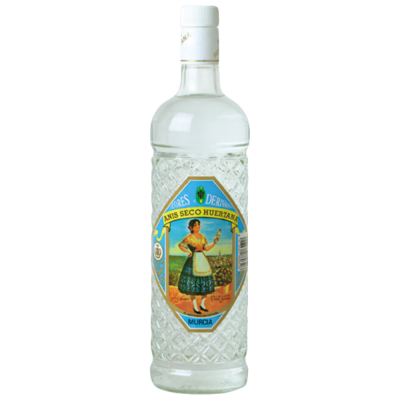HUERTANA DRY ANISEED 50% 1L
- Energy / kcal / 100 ml: 251.0
- Proteins / g / 100 ml: 1.2
- Carbohydrates / g / 100 ml: 23.10
- Of which sugars / o g / 100 ml: 23.10
- Fats / g / 100 ml: 6.50
- Of which saturated fatty acids / g / 100 ml:5.90
- Salt / g / 100 ml: 0.1
- Water
- Sugar
- Distilled alcohol
- Maltodextrin
- Vegetable fat (coconut)
- Tequila
- Milk proteins
- Flavorings
- Stabilizer E471
- Emulsifier E481
- Antioxidant E306
- Coloring agents E122
- Acidity regulator E524, E331
Contains milk and milk derivatives
Non irradiated product. Product does not contain GMO.
- Sales denomination: Liqueur
- Alcoholic strength: 17% Vol.
- Best before date: 24 months
- Code: 8413562001859
Store in a cool, dry place, away from sources of light and heat.
- Unit: Glass bottle
- Capacity: 1L
- Units per box: 12
- Boxes per layer: 9
- Layers per pallet: 5
- Boxes per pallet: 45
- Unit weight: 1.55 Kg
- Weight per box: 18.60 Kg
- Weight per pallet: 837 Kg
Information on the consumption of alcoholic beverages
Abusive or excessive consumption of alcoholic beverages may cause health risks.
Potential problems may result from improper consumption (by certain risk groups, such as minors, drivers, pregnant women) or excessive or abusive consumption. For more information, please consult your physician.
Equivalences

Responsible consumption guidelines
- Drink slowly, enjoying the drink and the moment of consumption.
- Alternate alcoholic and non-alcoholic beverages.
- Eat while consuming alcoholic beverages.
- Learn to differentiate the nuances, enjoy the characteristics given to the beverage by its production method and origin.
- And remember
- Don't drink if you are going to drive. Choose your Alternate Driver.
- Minors cannot and should not drink alcohol. It is everyone's obligation to avoid it.
- If you are pregnant, you should not consume any type of alcoholic beverage. It can harm the development of the fetus.
- Use extreme caution if you are taking any medication. They could alter the effect of the drugs.
- Be properly informed about alcoholic beverages. They all contain the same type of alcohol, ethanol. There are many myths associated with their consumption.
- Know your limits*. Never make an abusive consumption.
Low-risk consumption limits Ministry of Health
Glass Container Recycling, Environment and Sustainable Development
Recycling glass containers is key to fighting climate change and protecting the environment. Moreover, it is born from citizen action: the real driver of change! It is therefore closely linked to the UN's 2030 Urban Agenda, which sets out 17 Sustainable Development Goals (SDGs) to achieve fair and sustainable development. With a gesture as simple as taking your glass containers to the container, you are helping us to achieve important goals such as these and safeguard the environment. Be part of the change!
Your decision to separate glass containers to take them to the green container seems like a small gesture, but added to that of many, many other people, it has many positive effects on the environment
Environmental benefits of recycling glass containers
Recycling glass containers is a key element in the fight against climate change and the decarbonization of our economy. It is also essential in the transition to a more circular development model rooted in the 2030 Agenda. In this regard, thanks to the recycling of glass containers, it was possible to avoid the emission of 587,432 tons of CO2, an amount equivalent to that which would be emitted by circling the world 149 times by plane around the equator of the Earth.
On the other hand, in a context of energy crisis, the manufacture of new glass containers from recycled glass (or cullet) saves energy and avoids the extraction of raw materials. Thus, it has managed to save 723,351 MWh of energy, in that sense, the energy savings achieved through glass recycling per year is equivalent to about 147.92 million euros
The separate collection of glass containers is a success story in constant evolution. Thanks to the containers deposited in the igloos, it has been achieved:
- Avoid the emission of nearly 9 million tons of CO2 into the atmosphere, which is equivalent to circling the world by plane 2,268 times around the equator of the Earth.
- Save 11,037.281 MWh of energy, equivalent to the electricity consumption of hospitals in Spain for 2.5 years.
- Avoid the extraction of more than 18 million tons of raw materials, equivalent to 1,836 times the weight of the Eiffel Tower.

